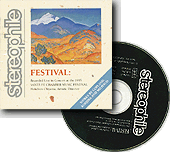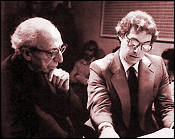| Columns Retired Columns & Blogs |
Festival! The Best of the 1995 Santa Fe Chamber Music Festival
The inspiration for this project came from Stereophile's Gretchen Grogan and Erich Vollmer of the Santa Fe Chamber Music Festival. Music Festivals are perhaps the healthiest aspect of classical music making, allowing ad hoc ensembles to chart the farthest reaches of the repertoire, as well as retracing the familiar ground of the great works. Why not, they thought, capture a representative selection of works performed at the 1995 Santa Fe Chamber Music Festival? This would not only document some of the great performances to be heard, but also allow music lovers everywhere to participate in what has increasingly been recognized as one of the US's best summer music festivals.
 For 23 years, the Santa Fe Chamber Music Festival has brought more than 50 internationally renowned musicians to Santa Fe for six weeks in July and August. Every summer the Festival presents more than 100 concerts, education and outreach programs, open rehearsals, and lectures in the beautiful Pueblo-styled St. Francis Auditorium of New Mexico's Museum of Fine Arts. Music lovers from all over the country come to enjoy the cool summer evenings at the foot of the Sangre de Cristo mountains and lose themselves in the world's most beautiful chamber-music repertoire.
For 23 years, the Santa Fe Chamber Music Festival has brought more than 50 internationally renowned musicians to Santa Fe for six weeks in July and August. Every summer the Festival presents more than 100 concerts, education and outreach programs, open rehearsals, and lectures in the beautiful Pueblo-styled St. Francis Auditorium of New Mexico's Museum of Fine Arts. Music lovers from all over the country come to enjoy the cool summer evenings at the foot of the Sangre de Cristo mountains and lose themselves in the world's most beautiful chamber-music repertoire.
Since its beginning in 1972, the Festival has been dedicated to presenting popular and lesser-known classical repertoire, as well as bringing to Santa Fe new works by contemporary composers. The Music of the Americas and Composer in Residence programs are part of the great variety that have given the Santa Fe Chamber Music Festival its reputation for vision and profundity.
The Music: Deborah Carley Emory & Tomiko Kohjiba
Aaron Copland (1900-1990)
Appalachian Spring Suite
(original version for chamber orchestra, 1943-44)
 Aaron Copland's extraordinary musical genius resulted in an amazing number of gifts not only to his native country but to the world as well. Ballets, theater pieces, and what is called "serious" music for the concert hall have become beloved perennial favorites that have enriched the lives of several generations of audiences.
Aaron Copland's extraordinary musical genius resulted in an amazing number of gifts not only to his native country but to the world as well. Ballets, theater pieces, and what is called "serious" music for the concert hall have become beloved perennial favorites that have enriched the lives of several generations of audiences.
Copland's greatest works came from the early years of World War II: the ballets Billy the Kid and Rodeo, the profoundly stirring Lincoln Portrait, and the brilliant Fanfare for the Common Man. Appalachian Spring is the most well known of Copland's orchestral works. This popularity may reflect its simplicity of intent, its boldly and tenderly treated folk idioms, and the enduring "American" character of its underlying story.
Two women who became legends in their own time were associated with the inception of this priceless contribution: arts patroness Mrs. Elizabeth Sprague Coolidge, whose foundation commissioned the ballet; and Martha Graham, the dancer who created the young woman's role in the first performance (given in the Coolidge Auditorium of the Library of Congress in October 1944).
Just the day before the premiere, Miss Graham had chosen the title, borrowing it from a poem by Hart Crane (to which the ballet's text, however, makes no reference). The story concerns a springtime wedding in Pennsylvania at the beginning of the 19th century. At their newly built farmhouse, the bride-to-be and her young intended experience the ageless emotions of joy and apprehension at their impending marriage and future life together. Neighbors, family, and a traveling revivalist all share in the nuptial celebration that ends with the young couple alone---"quiet and strong"---in their new home.
- Log in or register to post comments




































